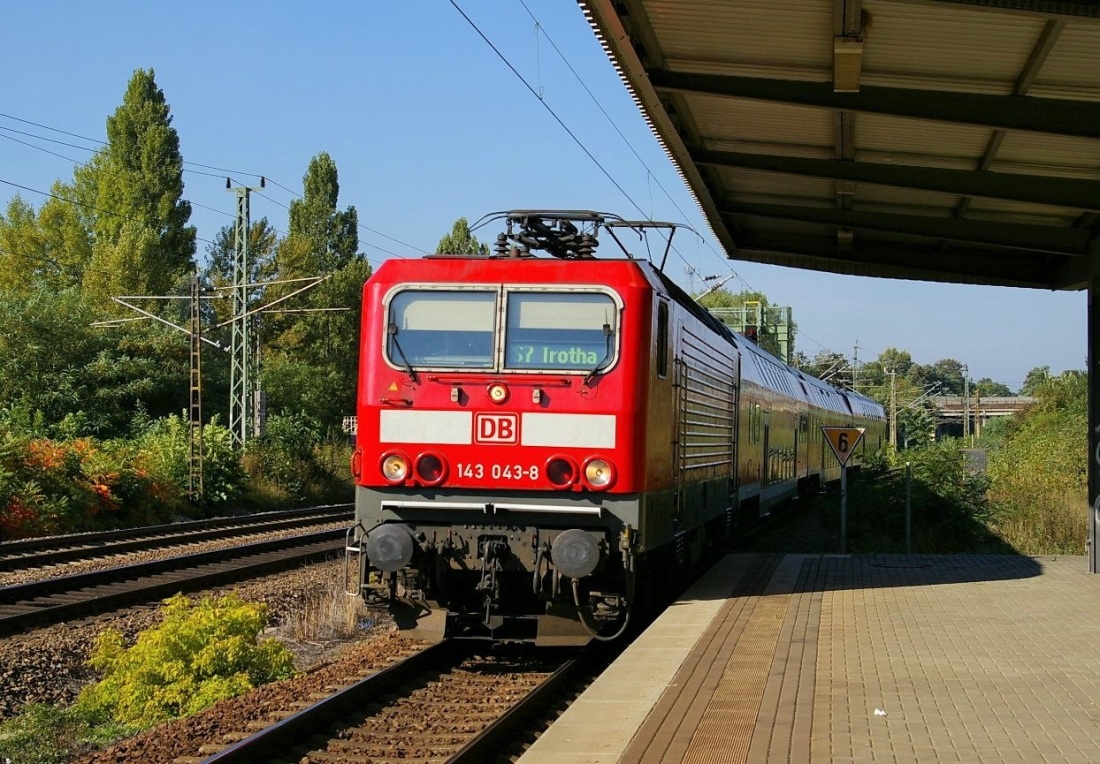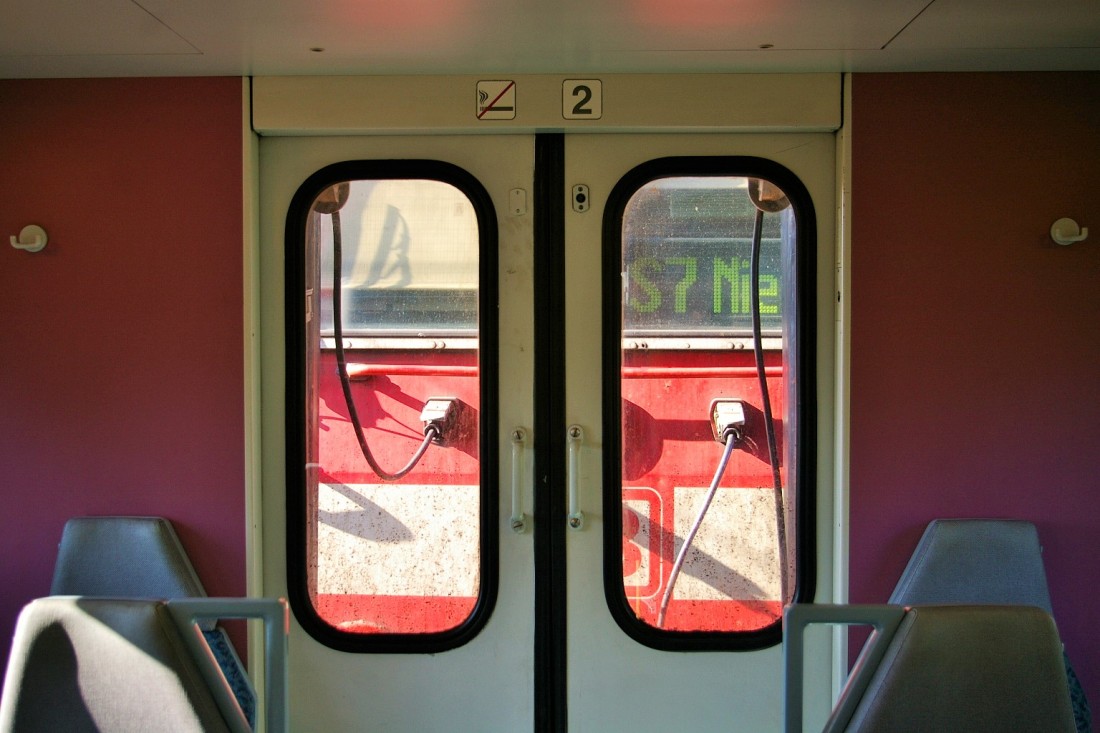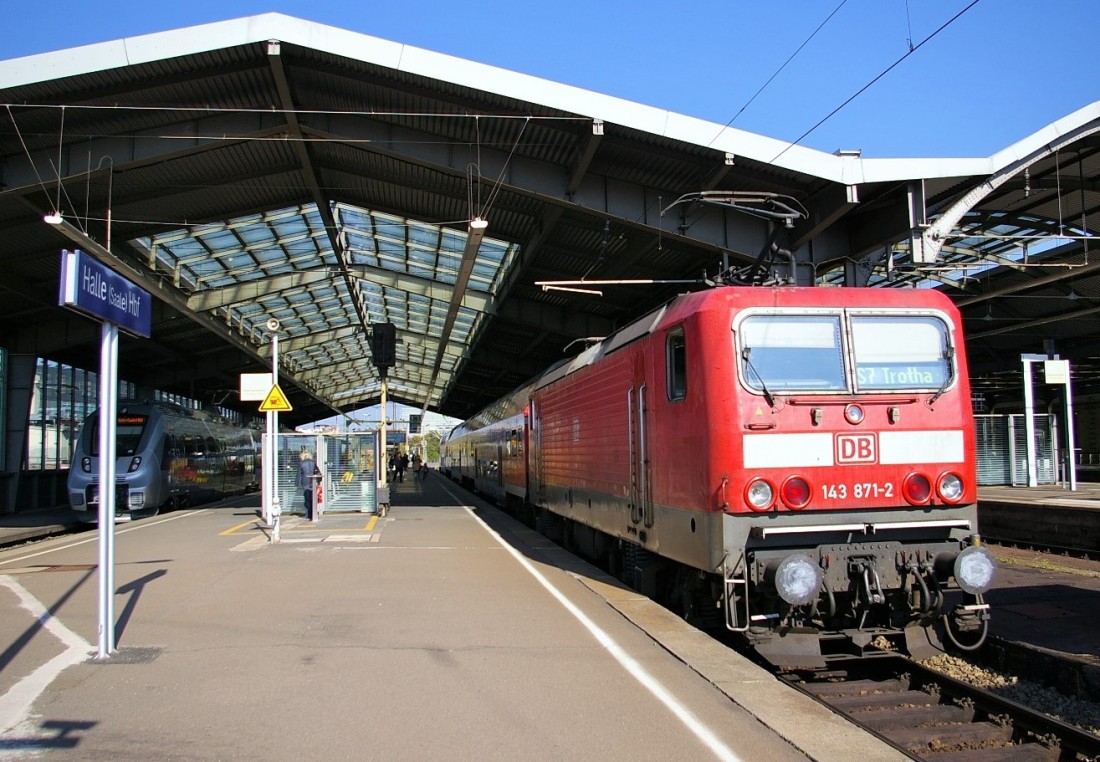Loco haulage on this route finally ended on 11th April 2018, but I’ll keep the article on the website for posterity as it has been popular – even though the S7 is now worked solely by EMUs, you may still like to visit this interesting corner of the former DDR!
Ironically, “Ostalgia” is big business. Nearly 30 years after German reunification, nostalgia for communist East Germany has never been more popular.
It seems that, with almost as much haste as the traces of the former country were wiped away following the fall of the Berlin Wall, people are now scrambling to experience what life was like behind it. You can drive a Trabant car in convoy around East Berlin on an innovative sightseeing tour, then stay at painstakingly-styled themed hotels. You can purchase clothes, food and all manner of other items of “reborn” Communist brands, recreated by popular demand. You can have your photo taken at Checkpoint Charlie in front of a replica border hut, with men dressed up as border guards.
Yet all of these experiences are in some way synthetic. This part of the world has experienced so many changes since the Berlin Wall fell in 1989, that it is nigh on impossible to recreate “everyday life” in any setting. After all, this was a country where you could realistically expect your intercity train to be powered by steam right up until the late 1980s. Today you can flash through the Sachsen-Anhalt countryside on some of the world’s most modern trains at speeds of up to 300 km/h.

143 043 arrives at Halle Silberhöhe, 30/09/13 (JW)
A small, but nonetheless very interesting exception exists in the vicinity of Halle (Saale), approximately 20 miles west of the city of Leipzig. Halle (Saale) is a city with a history visibly stretching back centuries, and there is plenty for the tourist to see there.
The area around Halle is known as big centre for the chemical industry, with both the famous Leuna and Buna plants a short distance away. These two gained particular importance in the post-war period when they were expropriated, expanded as part of the 1958 “Chemieprogramm” and used to supply the Soviet Union, jointly employing up to 50,000 people between them (equating to 1 in 350 of all the citizens of East Germany).
The mushrooming of industry here, the need for people to work there and the poor quality of housing elsewhere (much of it badly damaged by war) led to a fascinating East German project – the conception of a completely new and thoroughly modern city, known initially as the “Chemiearbeiterstadt West” (“Chemical Workers’ City – West”). Later refined to “Halle-Neustadt”, this was to be a short distance to the west of the existing city. Construction began on 15th July 1964 under the watchful eye of the architect Richard Paulick who oversaw the project.
“The laying of the foundation stone of Neustadt in 1964 was also that of the Halle S-Bahn network” Ralf Jacob, Halle city archivist
In stark contrast to the 700-year-old buildings of Halle, Neustadt was a futuristic (for the time) settlement consisting largely of grey concrete tower blocks known as “Plattenbauten”, synonymous with East Germany, designed to home over 90,000 people in total in nine Wohnkomplexe (“living complexes”). Perhaps bizarrely, none of Halle-Neustadt’s streets apart from the main drag (the “Magistrale”) had any names – each block was identified by a number only – although this is one thing that has since changed. Each Wohnkomplexe was intended to be pretty self-sufficient, featuring shops, restaurants etc, but the city’s primary function of a dormitory for the chemical workers was very close to the surface.

Basher’s eye view of 143 871 on the S7, 30/09/13 (JW)
Key to this was the creation of a public transport infrastructure to link the residential districts with each other, the chemical plants and also the original city of Halle. The centrepiece of this was the S-Bahn, the first part of which opened in 1967.
Halle S-Bahn
It may perhaps be a little odd to the 2017 observer to consider that this S-Bahn – a term we now largely associate with rapid transit operated by electric multiple units – was initially operated with Deutsche Reichsbahn V180-type diesel-hydraulic locos (later class 118, and DB class 228 after reunification) with up to 12 double-decker carriages in push-pull formation. These ran from the station now known as Halle Zscherbener Straße to Merseburg, Luna and Beuna and were supplemented by VT2.09 “pig taxis” to Halle (Saale) Hbf.
Electrification was soon to follow, along with new stations in the south of Halle-Neustadt as the city sprawled ever outwards and an extension through the Halle-Neustadt station (situated underground beneath the centre of the new city) through to Halle-Nietleben and Halle-Dölau. This allowed an electric S-Bahn service to be operated in an inverted “S” shape through the adjacent cities, beginning at Halle-Trotha and ending at Halle-Dölau – a distance of 22.8 km by rail, but less than 7 km as the crow flies. Traction for this was initially classes E11 and E42 (later DB class 109 and 142) electrics – as seen here in a rather impressive photo from after the fall of the Wall – and later the once-ubiquitous class 143 electric locos.

143 871 at Halle (Saale) Hbf, 30/09/13 (JW)
Halle-Neustadt Today
Halle-Neustadt’s initial strength has also proved to be its downfall. Conceived to home chemical workers, the plants are now shadows of their former selves, and this has had the predictable knock-on effect.
Home to 93,000 people at its peak, the turn of the century had seen Halle-Neustadt’s population reduce to 60,000, and now barely 40,000 live there. A startlingly high ratio of those people are the old people who were the young target market of the project 50 years ago. Many of the Plattenbauten lie empty, including those originally built for the families of the Soviet soldiers who built them. Consequently, some have even been demolished. Doubtless more will follow as the population gets older. Some modernisation has occurred – including to Halle-Neustadt’s S-Bahn station which retained this dilapidated throwback as late as 2009 – but generally, its East German character can still be very clearly seen.
Neither the direct link from Halle-Neustadt to Merseburg (2007), nor the section of line beyond Halle-Nietleben to Halle-Dölau (2002) retain a train service – although part of the latter saw its first train in 15 years in April 2017 when the Freunde der Halle-Hattstedter Eisenbahn ran a track machine along it (see news article here). For the meantime, though, the S7 route through Halle-Neustadt remains a little picture of a lost country.
The above is a link to a 9-minute YouTube video uploaded by user Berger Max neatly showing life on the S7 route in 2017. The deplorable state of Neustadt station can clearly be seen.
Halle S7 today – loco-hauled
The S7 is the remainder of the Trotha to Dölau route, now cut back to serve only Halle (Saale) Hbf to Halle-Nietleben. The section from the Hbf to Trotha has now been subsumed into an EMU-worked S-Bahn route from Leipzig.
Using East German traction (class 143) and East German-built double deck rolling stock, and running through as East German an environment as you are likely to find in 2018, this is probably as authentic as “Ostalgic” experience as any you could have.
Halle retains an allocation of five class 143s (143 034, 143 276, 143 810, 143 871 and 143 903) and the S7 represents 100% of their remaining booked work. This is now an oasis in a desert of suburban loco haulage – modern class 442 “Talent” EMUs having recently replaced locos on all but this route – although January 2018 has seen a couple of impromptu vice-unit appearances by 143s on route S9.
Two sets are employed on the route, operating at 30-minute intervals (xx:20 and xx:50 from both ends). If you simply wish to travel on both in the shortest time possible, then the “shack of choice” is Halle-Silberhöhe – you can depart from Hbf at xx:20, be at Silberhöhe from xx:28-33. This +5 is guaranteed to “make”, as Silberhöhe is a single-platform station. (It does, however, have the appearance of a former island platform – with a second platform face and ballast, but no track – this was never in fact laid, and was part of an uncompleted project to allow a 10-minute frequency along this route in the 1980s, such was the amount of usage that the line was getting).
This will get you back at the Hbf with both machines in your book by xx:41. (To note, these trains now use the new platform 13a at the Hbf, which is a few minutes’ – signposted – walk from the main station). However, if you have the time, I really would recommend a little wander into Halle-Neustadt.
Update 31/03/18 – From 18/04/18, the RE9 “Rhein-Sieg-Express” in the Köln area will have two class 442 “Hamster” EMUs replaced by two loco-hauled “Dosto” sets. It is expected that these will be the two sets from Halle currently used on the S7. This will mean that the 442s will move to Halle to work the S7, giving a common fleet in that area. I would not expect the 143s to move with the stock, so if you want to ride behind them, best to move quickly…
Another route for some 143’s is RB27 Koblenz Hbf – Rommerskirchen which I found out yesterday with 143.009 & 143.194 in action – I was not in Koln long enough to spot others.
LikeLiked by 2 people
Hi Peter – yes, that’s right, it’s where Trier’s remaining allocation work. Up to six 143s a day work the hourly service.
LikeLiked by 1 person